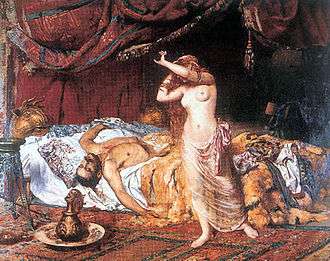Ildico
Ildikó (fl. AD 453) was the last wife of the Hunnic ruler Attila. Her name is East Germanic and suggests a Gothic origin. According to Priscus, Attila died after the feast celebrating their marriage in 453 AD, in which he suffered a severe nosebleed and choked to death in a stupor.

"Shortly before he died, as the historian Priscus relates, he took in marriage a very beautiful girl named Ildico, after countless other wives, as was the custom of his race. He had given himself up to excessive joy at his wedding, and as he lay on his back, heavy with wine and sleep, a rush of superfluous blood, which would ordinarily have flowed from his nose, streamed in deadly course down his throat and killed him, since it was hindered in the usual passages. Thus did drunkenness put a disgraceful end to a king renowned in war. On the following day, when a great part of the morning was spent, the royal attendants suspected some ill and, after a great uproar, broke in the doors. There they found the death of Attila accomplished by an effusion of blood, without any wound, and the girl with downcast face weeping beneath her veil.[1]"
Some writers, connecting Ildico to Kriemhild in the sagas of the Nieblungs, have suggested that Ildico deliberately killed Attila, in revenge for the death of her kinsmen.[2][3]
See also
- Gudrun, wife and murderess of Attila in Germanic and Norse sagas
References
- JORDANES. THE ORIGIN AND DEEDS OF THE GOTHS. translated by Charles C. Mierow. Transcribed by J. Vanderspoel, Department of Greek, Latin and Ancient History, University of Calgary.
- Ludlow, John Malcolm (1865). Popular epics of the middle ages of the Norse-German and Carlovingian cycles. Macmillan & C. pp. 93–4. OCLC 834760550.
- Tolkien, J. R. R. (John Ronald Reuel), 1892-1973. (2009). The legend of Sigurd and Gudrún. Tolkien, Christopher. Boston: Houghton Mifflin Harcourt. pp. Appendix A, S1. ISBN 9780547504711. OCLC 619981939.CS1 maint: multiple names: authors list (link)